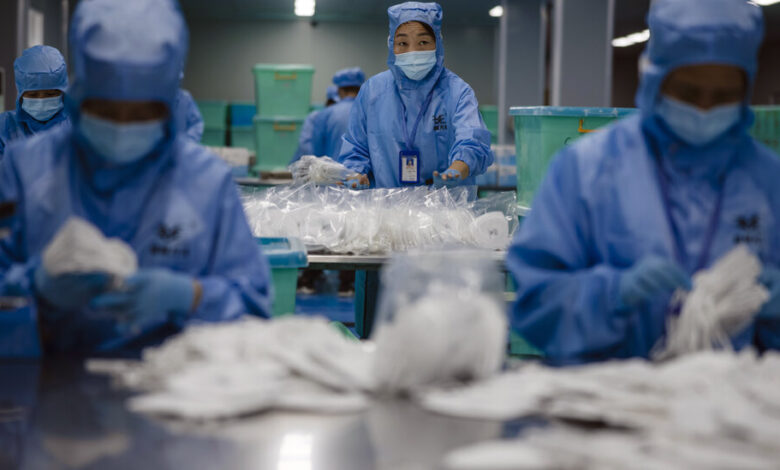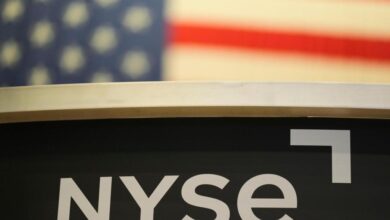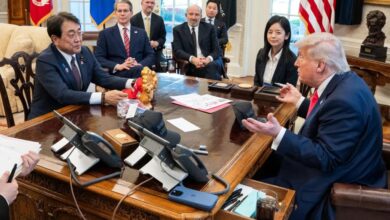Tariffs on China Aren’t Likely to Rescue U.S. Medical Gear Industry

The manufacturing industry in the United States, particularly producers of face masks, exam gloves, and other disposable medical gear, has suffered greatly due to the influx of cheap Chinese imports. This impact was particularly felt during the Covid pandemic when China halted exports, leaving American health care workers vulnerable to the deadly virus.
President Trump’s tariff implementation and Beijing’s subsequent retaliation have caused unease among the remaining American companies producing protective gear. While some see it as a step towards independence from China, others view it as irresponsible industrial policy.
Lloyd Armbrust, CEO of Armbrust American, expressed concern over the situation, stating, “I’m pretty freaked out.” The United States, once a dominant force in personal protective equipment production, now relies heavily on Chinese-made gear, despite previous promises to reduce dependency on foreign products.
The decline of the American P.P.E. sector in recent years has been disheartening, with only a few companies surviving the impact of slowing demand and the return of Chinese-made products. The tariffs on Chinese imports may provide American producers with an advantage, but industry experts fear supply chain disruptions and shortages as retaliatory measures escalate.
Despite efforts to revive domestic manufacturing, many companies that emerged during the pandemic have struggled to stay afloat. The loopholes in legislation aimed at promoting American-made medical equipment have allowed federal agencies to continue purchasing cheaper imports.
Industry leaders emphasize the need for policies that prioritize American-made products to ensure a stable supply of masks and gloves. The unpredictability of changing policies and the ability of Chinese manufacturers to bypass trade restrictions pose challenges for the sector.
The narrative of American entrepreneurialism rising to meet public health challenges has been overshadowed by the ongoing reliance on foreign-made medical gear. The fate of the American P.P.E. sector remains uncertain amidst global trade tensions and economic uncertainties.
Only a handful of companies that emerged during the pandemic are still in operation, highlighting the struggles faced by American manufacturers in the competitive market. Efforts to promote American-made products have been met with challenges, as demand for Chinese-made gear persists.
Some companies, like SafeSource Direct and Armbrust American, have managed to survive by catering to niche markets and emphasizing the quality of their American-made products. However, the broader issue of foreign dependency in the medical gear sector remains unresolved.
The ongoing challenges in the American P.P.E. sector underscore the need for comprehensive policies that prioritize domestic production. The reliance on foreign-made medical gear poses risks to national security and economic stability, requiring a concerted effort to promote American manufacturing.
While the future of the sector remains uncertain, industry leaders and policymakers must work together to address the systemic issues that have led to the current state of affairs. Only through strategic planning and collaboration can the American P.P.E. sector regain its footing and ensure a stable supply of essential medical gear.
As the debate over American-made medical gear continues, it is clear that the challenges facing the sector are complex and multifaceted. The impact of global trade dynamics, policy decisions, and market forces cannot be underestimated in shaping the future of the American P.P.E. industry.
Ultimately, the fate of the sector rests on the ability of industry leaders, policymakers, and stakeholders to work together towards a common goal of promoting domestic manufacturing and ensuring a stable supply of essential medical gear. Only through collective action and strategic planning can the American P.P.E. sector overcome its current challenges and thrive in an increasingly competitive global market.
The resilience of the American P.P.E. sector in the face of adversity is a testament to the ingenuity and determination of American manufacturers. Despite the challenges posed by foreign competition and market dynamics, companies like SafeSource Direct and Armbrust American have shown that American-made products can compete in the global market.
Moving forward, it is essential for industry leaders, policymakers, and stakeholders to continue supporting American manufacturing and promoting domestic production. By working together towards a common goal, the American P.P.E. sector can overcome its current challenges and ensure a stable supply of essential medical gear for the nation.
The need for a strategic and cohesive approach to promoting American manufacturing in the medical gear sector is more pressing than ever. The challenges posed by foreign competition, supply chain disruptions, and policy uncertainties require a concerted effort from all stakeholders to ensure the stability and growth of the American P.P.E. industry.
By prioritizing American-made products, supporting domestic manufacturers, and implementing comprehensive policies, the United States can reduce its dependency on foreign-made medical gear and strengthen its national security and economic resilience.
The future of the American P.P.E. sector hinges on the ability of industry leaders, policymakers, and stakeholders to collaborate and implement effective strategies for promoting domestic manufacturing. By prioritizing American-made products and supporting domestic producers, the United States can ensure a stable supply of essential medical gear and reduce its reliance on foreign imports.
As the industry navigates the challenges posed by global trade dynamics and policy uncertainties, it is essential for all stakeholders to work together towards a common goal of promoting American manufacturing and ensuring the resilience of the American P.P.E. sector.
The ongoing debate over American-made medical gear underscores the importance of promoting domestic manufacturing and reducing dependency on foreign imports. By prioritizing American-made products and supporting domestic producers, the United States can strengthen its national security and economic resilience.
As the industry faces challenges posed by global trade dynamics, policy uncertainties, and market forces, it is essential for industry leaders, policymakers, and stakeholders to collaborate and implement effective strategies for promoting American manufacturing in the medical gear sector.
The resilience of the American P.P.E. sector in the face of adversity is a testament to the ingenuity and determination of American manufacturers. Despite the challenges posed by foreign competition and market dynamics, companies like SafeSource Direct and Armbrust American have shown that American-made products can compete in the global market.
Moving forward, it is essential for industry leaders, policymakers, and stakeholders to continue supporting American manufacturing and promoting domestic production. By working together towards a common goal, the American P.P.E. sector can overcome its current challenges and ensure a stable supply of essential medical gear for the nation.
The challenges facing the American P.P.E. sector require a comprehensive and collaborative approach to promoting domestic manufacturing and reducing dependency on foreign imports. By prioritizing American-made products and supporting domestic producers, the United States can strengthen its national security and economic resilience.
Industry leaders, policymakers, and stakeholders must work together to address the systemic issues that have led to the current state of affairs in the American P.P.E. sector. Through strategic planning and collective action, the industry can overcome its challenges and thrive in an increasingly competitive global market.





